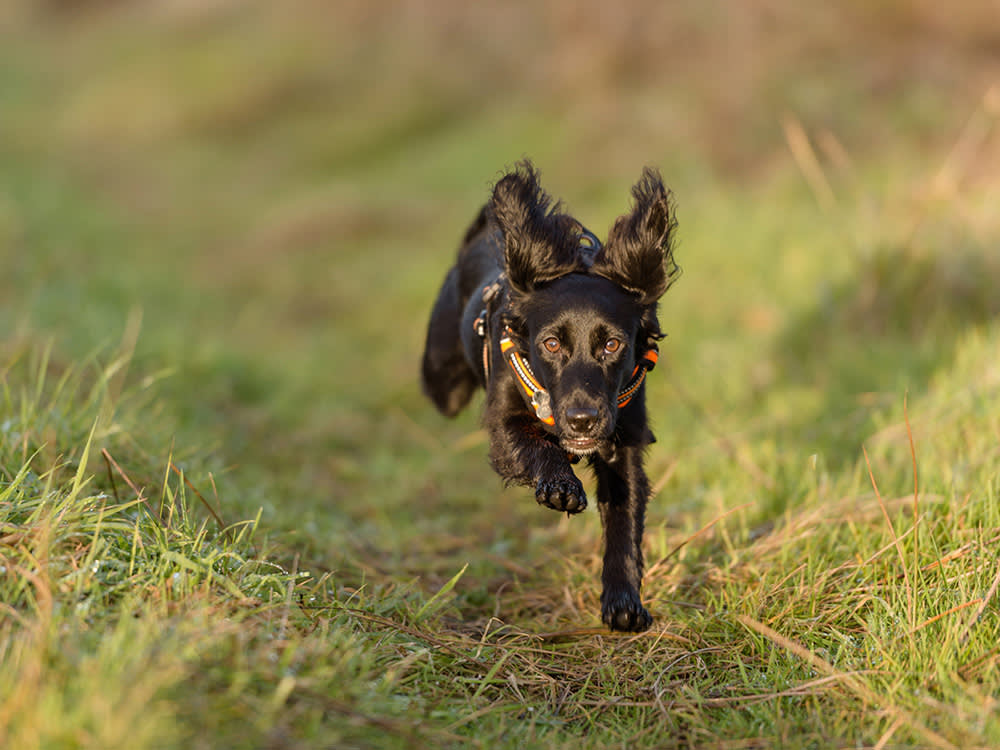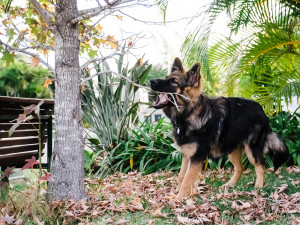Prey Drive in Dogs: Fact or Fiction?
Is the term “prey drive” correct terminology or jargon?

Share Article
If you have an urge to create discord and angst, here’s one way to do it: Go to a dog behavior conference or seminar and boldly state, “I think we should discuss the meaning of the term ‘prey drive,’ and decide whether or not we should continue to use it.” Then, make a dash for the exit before it gets ugly.
What is Prey Drive?
The term “prey drive” refers to a dog’s eagerness or desire, related to chasing and capturing prey. But, the terminology employed to describe canine behavior is messy, perhaps in part because dog behavior encompasses a number of disciplines, among them ethology, evolution, physiology, neurobiology, sociology, psychology, learning theory and animal husbandry.

littleKin™ is Kinship’s home just for puppy and kitten parents. Bop over to check out expert advice, new pet tools, and special deals—all curated for your newest family member.
opens in a new tabIt’s a trait that makes many dogs successful in the world of canine sports. The term is often used by people whose dogs participate in agility or fly ball as well as by those whose dogs work in search and rescue or law enforcement. Additionally, it has become increasingly popular when discussing dogs with various behavioral issues, typically issues related to chasing (cars, squirrels, runners, bikes, children) and the resulting difficulty in teaching them to comeopens in a new tab or to pay attentionopens in a new tab in general around any of these distractions.
Sometimes “prey drive” is used in a positive sense, as in, “She’s excited about working because she has a high prey drive. I love her enthusiasm and motivation, and the prey drive gives her such great endurance too.” It can also be used in a negative way, as in, “I can never let her off-leash in areas that aren’t fenced in. She has such high prey drive that she’ll chase anything. I can’t trust her to come back or stay out of trouble.” So, though prey drive is commonly used in the dog world, many people dislike it.
Are Dogs Driven to Chase?
From an ethological perspective, the term “prey drive” doesn’t make sense. If you ask an ethologist (someone who studies the behavior of animals in their natural environments) who isn't involved in the “dog world” — and the vast majority of them aren’t — what they think of the term, they will look at you quizzically and then criticize it on the grounds that it’s nonsensical.
To ethologists, the word “drive” refers to an unknown and variable internal state that explains why an animal’s response to a stimulus is not identical every time the animal is exposed to it. For example, at times, a dog may charge after a tennis ball with gleaming eyes and an over-the-top bouncy enthusiasm, while at other times, that same dog may lazily lope after the ball or even ignore it, though the stimulus (the thrown ball) is the same. What’s different is the dog’s interest in or motivation to chase it.
“Drive” is the term used to explain that difference, which ethologists consider to be a difference in internal states, perhaps based on neurological or physiological variables over time.
Fluctuation in an animal’s drive doesn’t just affect predatory behavior. It also influences how eager a dog is to eat, drink and engage in sexual behavior, or any other type of behavior for that matter. Yet, we don’t talk about food drive, water drive or potential-mating-partner drive. We say that a dog is hungry or food-motivated (or a chowhoundopens in a new tab); that the dog is thirsty; or, in the case of females, that she is sexually receptive. To be fair, the term “sex drive” is used to describe the state of having an interest in mating — referring typically (but not always) to males — but we don’t say female drive or male drive.
Even in the way that many people use it, prey drive lacks precision. Does it mean a drive to run, to chase, to catch something, to bite it, to kill it or any combination of these? Is it all related to predatory behavior, and if so, why is the term “prey drive” used, rather than “predatory drive”
Prey Drive, Aggression and Impulse Control
Words and phrases that express precise concepts are indispensable for communication, and the more specific we can be, the better. However, the inexactness of language can make it a challenge to convey precise meanings. For example, because English is short on words that describe emotional nuance, people say things such as, “Do you like him or do you like him?”
Some people feel that the word “drive” doesn’t actually explain an animal’s behavior. In one sense, it’s an oversimplification to say that an animal is behaving a certain way because of an internal state or a change in that internal state. We know that an animal’s motivation changes over time and that different members of the same species behave differently in the presence of identical stimuli, but we don’t often know why. So, the term is more descriptive and less explanatory than it purports to be. A label such as “prey drive” is essentially a shorthand way to describe what we don’t understand since we don’t have complete knowledge of dogs’ internal states and their effect on behavior.
Another problem with prey drive is that it is often used in an attempt to explain a dog’s unwanted behavior toward other dogs and even people, neither of which are normally objects of canine predatory focus. We’ve all heard people dismiss a dog’s inappropriate, undesirable and sometimes even aggressive behavior with the comment that the dog has a high prey drive. It sounds so much nicer than saying that the dog has little impulse controlopens in a new tab, a far-from-ideal temperament or has not been the beneficiary of sufficient training.
Better Suited Term?
Criticisms of the phrase may be a predictable result of the fact that often, when terms are appropriated from other fields, they are used in a slightly different way. The current meaning of terms in our field may not match their original use, which can cause confusion and thus, a tendency to consider that the way the terms are being used is “wrong.” The concept of drive, which comes from the academic discipline of ethology, has come to mean something different, though related, in the world of dogs.
It’s wise to acknowledge that terms have to be considered in context. Would it be better if no such confusion ever arose and multiple meanings didn’t exist? Sure, there would be advantages, but the reality is that languages change, as do fields of study and their associated terminology.
Cultures vary in the way they accept and integrate shifting meanings in the language used to describe the world around them. On one extreme, the French are well known for their strong national pride in the stability of their language, and the great importance they place on maintaining le bon usage (the correct usage) and resisting change, particularly Anglicisms. At the other extreme is the surfer culture with its enthusiastic proliferation of new words and phrases such as “tubular,” “hang ten,” “in the soup” and “goofy footed.” Americans generally accept new words and phrases easily, accounting for the rapid spread of “going postal,” “cougar,” “to be plutoed” and, most recently, “Tebowing.”
Finding a Balance
While some folks enjoy referring to “predatory drift” and “reactivityopens in a new tab” (the term “aggressionopens in a new tab” used to suffice), and “prey drive.” Others would prefer to hear that a dog is enthusiastic about agility or fly ball, or that the dog is motivated to run the course, take the jumps or retrieve a ball. What’s important is that we understand one another.
The reality is that when most people talk about prey drive in dogs, they are referring to the enthusiasm and strong motivation that makes dogs sharp on the course, eager to participate and reliably give their all in competition or in play.

Karen B. London, PhD, CAAB, CPDT-KA
Karen B. London, Ph.D., is a Certified Applied Animal Behaviorist and Certified Professional Dog Trainer who specializes in working with dogs with serious behavioral issues, including aggression, and has also trained other animals including cats, birds, snakes, and insects. She writes the animal column for the Arizona Daily Sun and is an Adjunct Professor in the Department of Biological Sciences at Northern Arizona University. She is the author of six books about training and behavior, including her most recent, Treat Everyone Like a Dog: How a Dog Trainer’s World View Can Improve Your Lifeopens in a new tab.
Related articles
![Dog looking out of a red half-door]() opens in a new tab
opens in a new tabHow to Stop Your Escape-Artist Dog From Making a Getaway
Dog trainer Pat Miller’s pro tips for preventing your pup from darting out the door.
![German Shepherd puppy pulling at a branch]() opens in a new tab
opens in a new tabDog Life Stages: Puppy Adolescence Is Only a Phase
What to expect when your perfect puppy hits that unruly stage.
![A couple int he living room playing with a laser on the couch with their dog]() opens in a new tab
opens in a new tabAre Laser Pointers Bad for Dogs?
Learn why these red beams of light are bad for dogs.
![Bearded man on a run encounters a dog on the beach]() opens in a new tab
opens in a new tabStrategies for Encountering Dogs While Running
Tips on what to do if a dog chases you.






